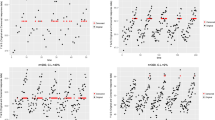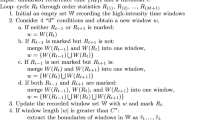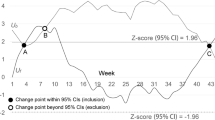Abstract
This study aims to detect the most recent changepoint in censored panel data by ignoring dependence within and between segments as well as taking into account the serial autocorrelation. A comparison of different methods to detect the most recent changepoint for censored data is presented. Different censoring rates such as 20%, 50%, and 90% in the case of right and left censoring while (10%, 10%), (25%, 25%) and (40%, 50%) for interval censoring are considered. Further, we use most recent changepoint (MRC), double cumulative sum binary segmentation, non parametric changepoint detection (ECP), multiple changepoints in multivariate time series, analyzing each series in the panel independently, and analyzing aggregated data (AGG) methods. It is observed that different censoring rates have a significant effect on the detection of changepoints in high dimensional data. It is also noticed that the MRC method outperforms the competing methods considered in this study. In addition to investigating the impact of penalties, the performance of MRC and AGG methods is also compared using water quality data of the Niagara River. Also, a data set related to survival time of stroke patients is also a part of this study. An R package “cpcens” is available in comprehensive R archive network to replicate the results of this article.


Similar content being viewed by others
References
Aston JA, Kirch C (2014) Efficiency of change point tests in high dimensional settings. arXiv preprint arXiv: 1409.1771
Bardwell L (2018) Efficient search methods for high dimensional time-series. Ph.D. thesis, Lancaster University
Bardwell L, Fearnhead P, Eckley IA, Smith S, Spott M (2019) Most recent changepoint detection in panel data. Technometrics 61(1):88–98
Bellman RE, Dreyfus SE (2015) Applied dynamic programming. Princeton University Press, Princeton
Cao H, Biao Wu W (2015) Changepoint estimation: another look at multiple testing problems. Biometrika 102(4):974–980
Charikar M, Guha S, Tardos É, Shmoys DB (2002) A constant-factor approximation algorithm for the k-median problem. J Comput Syst Sci 65(1):129–149
Cho H et al (2016) Change-point detection in panel data via double CUSUM statistic. Electron J Stat 10(2):2000–2038
Cho H, Fryzlewicz P (2015) Multiple-change-point detection for high dimensional time series via sparsified binary segmentation. J R Stat Soc Ser B (Stat Methodol) 77(2):475–507
Cohen AC (2016) Truncated and censored samples: theory and applications. CRC Press, Boca Raton
Coolen F, Yan K (2004) Nonparametric predictive inference with right-censored data. J Stat Plan Inference 126(1):25–54
Cryer J, Chan K (2008) Time series analysis: with applications in R. Springer, Berlin
Davis RA, Lee TCM, Rodriguez-Yam GA (2006) Structural break estimation for nonstationary time series models. J Am Stat Assoc 101(473):223–239
Fearnhead P, Rigaill G (2019) Changepoint detection in the presence of outliers. J Am Stat Assoc 114:169–183
Fryzlewicz P (2014) Wild binary segmentation for multiple change-point detection. Ann Stat 42(6):2243–2281
Grünwald PD (2007) The minimum description length principle. MIT Press, Cambridge
Haynes K, Eckley IA, Fearnhead P (2017) Computationally efficient changepoint detection for a range of penalties. J Comput Graph Stat 26(1):134–143
Helsel DR (2011) Statistics for censored environmental data using Minitab and R. Wiley, New York
Hewett P, Ganser GH (2007) A comparison of several methods for analyzing censored data. Ann Occup Hyg 51(7):611–632
Horváth L, Hušková M (2012) Change-point detection in panel data. J Time Ser Anal 33(4):631–648
James NA, Matteson DS (2013) ecp: An R package for nonparametric multiple change point analysis of multivariate data. arXiv preprint arXiv:1309.3295
Jandhyala V, Fotopoulos S, MacNeill I, Liu P (2013) Inference for single and multiple change-points in time series. J Time Ser Anal 34(4):423–446
Killick R, Fearnhead P, Eckley IA (2012) Optimal detection of changepoints with a linear computational cost. J Am Stat Assoc 107(500):1590–1598
Kirch C, Muhsal B, Ombao H (2015) Detection of changes in multivariate time series with application to EEG data. J Am Stat Assoc 110(511):1197–1216
Lavielle M (2005) Using penalized contrasts for the change-point problem. Sig Process 85(8):1501–1510
Lavielle M, Moulines E (2000) Least-squares estimation of an unknown number of shifts in a time series. J Time Ser Anal 21(1):33–59
Lavielle M, Teyssiere G (2006) Detection of multiple change-points in multivariate time series. Lith Math J 46(3):287–306
Leung K-M, Elashoff RM, Afifi AA (1997) Censoring issues in survival analysis. Annu Rev Public Health 18(1):83–104
Ma TF, Yau CY (2016) A pairwise likelihood-based approach for changepoint detection in multivariate time series models. Biometrika 103(2):409–421
Maidstone R, Hocking T, Rigaill G, Fearnhead P (2017) On optimal multiple changepoint algorithms for large data. Stat Comput 27(2):519–533
Matteson DS, James NA (2014) A nonparametric approach for multiple change point analysis of multivariate data. J Am Stat Assoc 109(505):334–345
Mei Y (2011) Quickest detection in censoring sensor networks. In: 2011 IEEE international symposium on information theory proceedings (ISIT), pp 2148–2152. IEEE
Miller RG Jr (2011) Survival analysis. Wiley, New York
Mohammad NM (2014) Censored Time Series Analysis. Electronic Thesis and Dissertation Repository. 2489. https://ir.lib.uwo.ca/etd/2489
Nemhauser G, Wolsey L (1988) Integer programming and combinatorial optimization. Wiley, New York
Park JW, Genton MG, Ghosh SK (2007) Censored time series analysis with autoregressive moving average models. Can J Stat 35(1):151–168
Preuss P, Puchstein R, Dette H (2015) Detection of multiple structural breaks in multivariate time series. J Am Stat Assoc 110(510):654–668
Reese J (2006) Solution methods for the p-median problem: an annotated bibliography. Netw Int J 48(3):125–142
Robinson PM (1980) Estimation and forecasting for time series containing censored or missing observations. In: Anderson OD (ed) Time series. North Holland, Amsterdam, New York, pp 167–182. Proceedings of the international conference held at Nottingham University
Taha HA (2017) Operations research: an introduction. Pearson, London
Teitz MB, Bart P (1968) Heuristic methods for estimating the generalized vertex median of a weighted graph. Oper Res 16(5):955–961
Vert J-P, Bleakley K (2010) Fast detection of multiple change-points shared by many signals using group LARS. In: Advances in neural information processing systems, pp 2343–2351
Wang T, Samworth RJ (2018) High dimensional change point estimation via sparse projection. J R Stat Soc Ser B (Stat Methodol) 80(1):57–83
Wooldridge JM (2010) Econometric analysis of cross section and panel data. MIT Press, Cambridge
Xie Y, Siegmund D (2013) Sequential multi-sensor change-point detection. Ann Stat 41:670–692
Yao Y-C (1987) Approximating the distribution of the maximum likelihood estimate of the change-point in a sequence of independent random variables. Ann Stat 15(3):1321–1328
Zeger SL, Brookmeyer R (1986) Regression analysis with censored autocorrelated data. J Am Stat Assoc 81(395):722–729
Zhang NR, Siegmund DO (2007) A modified bayes information criterion with applications to the analysis of comparative genomic hybridization data. Biometrics 63(1):22–32
Acknowledgements
The authors would like to thanks the editor, associate editor, and anonymous reviewers for their constructive and critical comments to improve the quality of the article.
Author information
Authors and Affiliations
Corresponding author
Additional information
Publisher's Note
Springer Nature remains neutral with regard to jurisdictional claims in published maps and institutional affiliations.
Electronic supplementary material
Below is the link to the electronic supplementary material.
Appendices
Appendix
A. The double CUSUM binary segmentation algorithm
Let \({\mathcal {I}}_{s,d} = [s,s + e_{T}] \cup [d - e_{T},d]\) represent a fraction of the interval [s,d] and we do not search for the changepoints on this interval in order to account for possible bias. Let the index u is used to represent the level and v represents the location of the node at each level. Then repeat the following steps.
- Step 1:
-
Set (u,v) = (1,1), \(s_{u,v}\) = 1 and \(d_{u,v}\) = T
- Step 2:
-
At current level u, repeat the following steps for all v.
- Step 2.1:
-
Let s = \(s_{u,v}\) and d = \(d_{u,v}\), obtain the CUSUMs series \({\chi ^{(k)}_{s,b,d}}\) for \(b \in [s,d)\) and \(k = 1,\ldots ,n\), on which \(D_{m}^{\varphi }({\{|\chi ^{(k)}_{s,b,d}|}\} _{k=1}^{n})\) is computed over all b and m.
- Step 2.2:
-
Obtain the test statistic
$$\begin{aligned} T_{s,d}^{\varphi } = \mathrm {{\underset{b\in [s,d] \ {\mathcal {I}}_{s,d} }{\max } \underset{1\le m\le n}{max}}}D_{m}^{\varphi }({\{|\chi ^{(k)}_{s,b,d}|}\}_{k=1}^{n}). \end{aligned}$$where
$$\begin{aligned} D_{m}^{\varphi }({\{|\chi ^{(k)}_{s,b,d}|}\}_{k=1}^{n})&= \Big \{\frac{m(2n-m)}{2n}\Big \}^{\varphi }\Bigg (\frac{1}{m}\sum \limits _{k=1}^{m}|\chi _{s,b,d}^{(k)}|-\frac{1}{2n-m}\sum \limits _{k=m+1}^{n}|\chi _{s,b,d}^{(k)}|\Bigg ) \\&= \Big \{\frac{m(2n-m)}{2n}\Big \}^{\varphi }\frac{1}{m}\sum \limits _{k=1}^{m}\Bigg (|\chi _{s,b,d}^{(k)}|-\frac{1}{2n-m}\sum \limits _{k=m+1}^{n}|\chi _{s,b,d}^{(k)}|\Bigg ) \end{aligned}$$the \(D^{\varphi }_{m}\) (DC operator) takes the ordered CUSUM values \(|\chi _{s,b,d}^{(1)}|\ge |\chi _{s,b,d}^{(2)}|\ge \cdots \ge |\chi _{s,b,d}^{(n)}|\) at each b, as its input for some \(\varphi \in [0,1]\).
- Step 2.3:
-
If \(T^ {\varphi }_{s,d} \le \pi ^{\varphi }_{n,T}\), stop searching for changepoints on the interval [s,d]. On the other hand, if \(T^ {\varphi }_{s,d} \ge \pi ^{\varphi }_{n,T}\), locate
$$\begin{aligned} {\widehat{\eta }} = \mathrm {{arg\underset{b\in [s,d] \ {\mathcal {I}}_{s,d} }{\max } \underset{1\le m\le n}{max}}}D_{m}^{\varphi }({\{|\chi ^{(k)}_{s,b,d}|}\}_{k=1}^{n}). \end{aligned}$$and proceed to Step 2.4.
- Step 2.4:
-
Add \({\widehat{\eta }}\) to the set of estimated changepoints and divide the interval \([s_{u,v},d_{u,v}]\) into two sub-intervals \([s_{u+1,2v-1},d_{u+1,2v-1}]\) and \([s_{u+1,2v},d_{u+1,2v}]\), where \(s_{u+1,2v-1} = s_{u,v}, d_{u+1,2v-1}\) = \( {\widehat{\eta }}\), \(s_{u+1,2v} = {{\widehat{\eta }}} + 1 \) and \(d_{u+1,2v} = d_{u,v}\).
- Step 3:
-
Once \([s_{u,v},d_{u,v}]\) for all v are examined at level u, set u \(\leftarrow \) u + 1 and go to Step 2. Step 2.3 furnishes a stopping rule to the DCBS algorithm: quit the search for further changepoints when \(T^ {\varphi }_{s,d} \le \pi ^{\varphi }_{n,T}\) on every [s,d] defined by two adjacent estimated changepoints.
Rights and permissions
About this article
Cite this article
Siddiqa, H., Ali, S. & Shah, I. Most recent changepoint detection in censored panel data. Comput Stat 36, 515–540 (2021). https://doi.org/10.1007/s00180-020-01028-5
Received:
Accepted:
Published:
Issue Date:
DOI: https://doi.org/10.1007/s00180-020-01028-5




